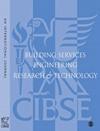Research on the design and application of capillary heat exchangers for heat pumps in coastal areas
IF 1.8
4区 工程技术
Q3 CONSTRUCTION & BUILDING TECHNOLOGY
Building Services Engineering Research & Technology
Pub Date : 2021-05-01
DOI:10.1177/01436244211001497
引用次数: 4
Abstract
This study investigated the optimal design of a capillary heat exchanger device for the heat pump system and its innovative engineering application in a building. The overall aim was to use a capillary heat exchanger to obtain energy in coastal areas for promoting renewable energy in low-carbon building design. Initially, the main factors affecting the efficiency of the capillary heat exchanger were identified, a mathematical model was then established to analyse the heat transfer process. The analysis showed the flow rate and the capillary length are the key factors affecting the efficiency of the capillary heat exchanger. Secondly, to optimize the structural design of the capillary heat exchanger, the heat energy transfer is calculated with different lengths of the capillary under various flow rates in summer and winter conditions, respectively. Thirdly, a typical building is selected to analyse the application of the capillary heat exchanger for extracting energy in the coastal area. The results show the performance of the selected capillary heat exchanger heat pump system, in winter, the heat energy transfer rate is 60 W/m2 when the seawater temperature is 3.7 °C; in summer, the heat energy transfer rate is 150 W/m2 when the seawater temperature is 24.6 °C. Finally, the above field test results were examined using a numerical simulation model, the test and simulation results agree with each other quite well. This paper is conducive in promoting the development of the capillary heat exchanger heat pump as an innovative sustainable technology for net-zero energy and low carbon buildings using renewable energy in coastal areas. Practical application: A recently proposed capillary heat exchanger is used as an energy extraction and utilisation device to obtain energy in coastal areas for promoting renewable energy in low-carbon building design. This paper explores the application of a capillary heat exchanger as both cold and heat sources for application in typical low-rise buildings. The analysis of the heat energy transfer rate of a typical low-rise building located in a coastal area in summer and winter provides guidance for the application of capillary heat exchangers.沿海地区热泵用毛细管换热器的设计与应用研究
本文研究了用于热泵系统的毛细管换热器装置的优化设计及其在建筑中的创新工程应用。总体目标是在沿海地区使用毛细管换热器获取能源,以促进低碳建筑设计中的可再生能源。首先,确定了影响毛细管换热器效率的主要因素,然后建立了数学模型来分析换热过程。分析表明,流量和毛细管长度是影响毛细管换热器效率的关键因素。其次,为了优化毛细管换热器的结构设计,分别在夏季和冬季条件下,计算了不同长度毛细管在不同流速下的热能传递。第三,选取一栋典型的建筑,分析了毛细管换热器在沿海地区的应用。结果表明,所选用的毛细管换热器热泵系统的性能,在冬季,热能传递率为60 海水温度为3.7时的W/m2 °C;在夏季,热能传递率为150 海水温度为24.6时的W/m2 °C。最后,利用数值模拟模型对上述现场试验结果进行了验证,试验结果与模拟结果吻合较好。本文有利于促进毛细管换热器热泵作为一种创新的可持续技术的发展,用于沿海地区使用可再生能源的净零能源和低碳建筑。实际应用:最近提出的毛细管换热器被用作沿海地区的能源提取和利用装置,以促进低碳建筑设计中的可再生能源。本文探讨了毛细管换热器作为冷热源和热源在典型低层建筑中的应用。对沿海地区典型低层建筑夏冬季热能传递率的分析,为毛细管换热器的应用提供了指导。
本文章由计算机程序翻译,如有差异,请以英文原文为准。
求助全文
约1分钟内获得全文
求助全文
来源期刊

Building Services Engineering Research & Technology
工程技术-结构与建筑技术
CiteScore
4.30
自引率
5.90%
发文量
38
审稿时长
>12 weeks
期刊介绍:
Building Services Engineering Research & Technology is one of the foremost, international peer reviewed journals that publishes the highest quality original research relevant to today’s Built Environment. Published in conjunction with CIBSE, this impressive journal reports on the latest research providing you with an invaluable guide to recent developments in the field.
 求助内容:
求助内容: 应助结果提醒方式:
应助结果提醒方式:


